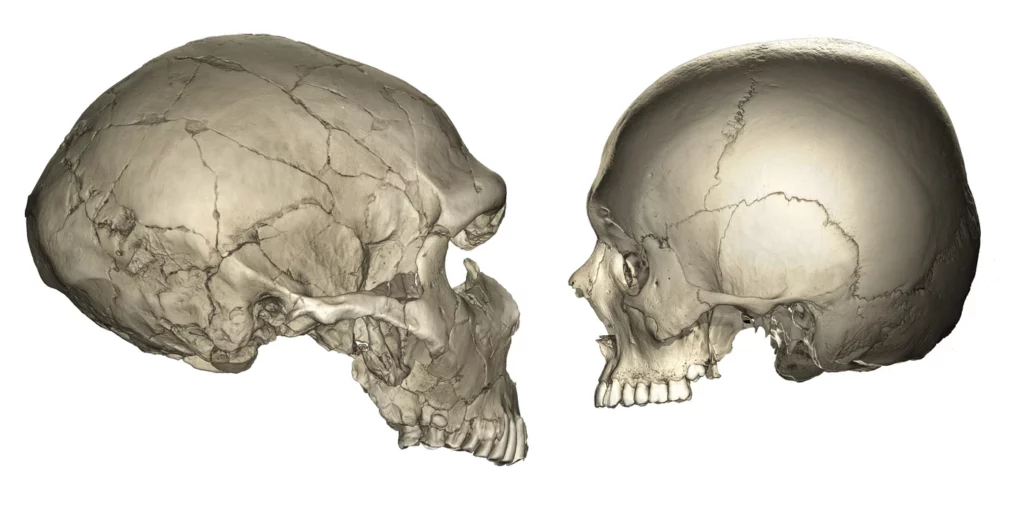
Our faces don’t just distinguish us from other people, but other species as well. Neanderthals bore stout jaws and broad noses, their features jutting forward like cliffs of bone. Chimpanzees, our distant cousins, wear visages built for strength. Modern humans, by contrast, have modest and meek faces — small, flat, and delicate.
In a new study, researchers have uncovered a fundamental difference in how human faces grow compared to those of our extinct cousins, the Neanderthals, and our primate relatives, chimpanzees. Using a combination of 3D scans, geometric modeling, and microscopic surface analyses, the team has mapped the development of the midface — the part of the skull that includes the nose and upper jaw — from infancy to adulthood.
The scientists at the Max Planck Institute for Evolutionary Anthropology in Germany found that the human face, unlike that of Neanderthals or chimpanzees, stops growing during adolescence.
“Our findings reveal that a change in development — particularly during late growth stages — led to smaller faces”, says first author Alexandra Schuh from the Max Planck Institute for Evolutionary Anthropology. “Compared to Neanderthals and chimpanzees who continue growing longer, human facial growth stops earlier, around adolescence, resulting in a smaller adult face.”
A Tale of Three Faces

Human faces are famously flatter than those of other primates. Neanderthals, by contrast, had prominent, projecting midfaces with broad noses and massive cheekbones — features often described as “robust.” Chimpanzees, too, wear their faces further forward.
This new study looked at the “how” behind those differences.
Using skulls of 128 modern humans from around the globe, 33 chimpanzees, and 13 Neanderthals — some mere infants, others fully grown — the researchers tracked how the face changes over time. They measured not just the shape and size of the bones but also the cellular activity happening on their surfaces.
Two processes sculpt the bones of the face: bone formation and bone resorption. Picture tiny sculptors adding and shaving away material, cell by cell. By examining where and how these molecular sculptors worked during different stages of life, the team could reconstruct facial growth (even in the extinct Neanderthals).
In chimpanzees and Neanderthals, face restructuring occurred for a long time. Their faces kept growing and projecting forward well into adolescence. Neanderthals, in particular, showed strong activity in areas around the nose and cheeks that pushed the midface outward — consistent with earlier studies suggesting their facial form may have helped them breathe better in cold climates or chew with great force.
But in humans?
“We found that growth slows dramatically earlier in adolescence,” the scientists wrote. That slow-down isn’t just in timing — it’s visible under the microscope. Modern humans showed less bone resorption across the face, a sign of reduced cellular activity.
Gracile Humans
This early slowdown is one piece of a broader evolutionary trend known as gracilization — the tendency for modern humans to become more delicate in form. Our bones are thinner, our muscles smaller, and our faces flatter than those of earlier hominins.
But why?
Some anthropologists point to changes in diet. As tools and cooking made food easier to chew, we may have lost the need for large, stress-resistant jaws and teeth. Others link the change to brain development. As our brains grew and our skulls restructured to accommodate them, the face may have been pushed downward and inward.
Still others suggest something even more unexpected: our own personalities. According to the “self-domestication” hypothesis, humans may have selected over generations for more sociable, less aggressive individuals. Just as dogs evolved floppy ears and shorter snouts through domestication, humans may have evolved flatter faces as a by-product of becoming nicer. This latter idea is certainly speculative (almost comically so), but so are the rest. The truth is that we don’t know “why” human faces stopped growing earlier than Neanderthals; again, this is a study about “how”.
“Identifying key developmental changes allows us to understand how species-specific traits emerged throughout human evolution”, says Schuh.
What If Human Faces Grew Like Neanderthals?
The researchers wondered what would happen if a Neanderthal baby’s face grew following a human timeline or if a chimpanzee’s face grew like a Neanderthal’s. So they ran some simulations to find out.
When Neanderthal infants were modeled to grow like modern humans, their adult faces ended up unusually small and retracted — essentially, looking more human. Flip the script, and human infants grown on a Neanderthal timeline developed massive, projecting faces.
“Species-specific differences in growth and bone remodeling shape adult morphology in significant ways,” the study concludes.
In other words, the path taken — the tempo and pattern of growth — carves the face as surely as genetics do.
The findings appeared in the Journal of Human Evolution.
This article originally appeared in March 2025 and was updated with new information.









